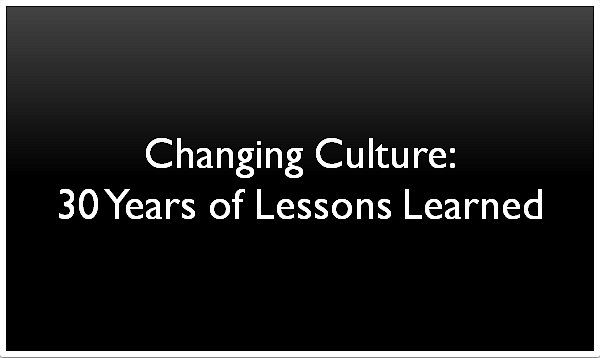Lesson 4: Who Are Your Leaders?
Culture is created by shared experience, but it is the leader who initiates this process by acting out his or her beliefs, values, and assumptions in the behaviors he or she demonstrates and the practices he or she uses.
So far, we have focused on senior leaders due to the power they have to drive change. Specifically, we’ve examined how a senior leader can shift culture by intentionally using the tools at his or her disposal. When this is done effectively, change within his or her sphere of influence is pretty much guaranteed.
Yet, it isn’t only people in senior leadership roles who have influence. Anyone in a management position has the capacity to affect the people reporting to them, while highly regarded individuals in non-management roles influence their peers and others in their network. In other words, every leader regardless of level can influence culture however, the extent depends on their sphere of influence.
This is important for two reasons. For one, if you can identify the leaders in your organization with the largest spheres of influence then align and engage them in culture change, you can accelerate the change process significantly. Second, focusing on high influence leaders allows for a targeted approach and investment that optimizes the use of precious resources while achieving the desired outcomes. This doesn’t mean you ignore the rest of the organization. Obviously, other people with less influence are part of the culture and need to be considered in the change effort. The difference is in the strategies you use to engage them.
A Leader’s Sphere of Influence
A leader’s sphere of influence refers to the people and things (that is; policies, processes, structures, space and so on) directly or indirectly affected by his or her actions. The size and scope of the sphere of influence is determined, in part, by the person’s role, responsibilities and relationships. In other words, the more senior you are, the greater your potential influence and capacity to effect change.
In a small organization, the senior leader or leadership team is typically involved in most if not all aspects of operations, thus their sphere of influence is extensive and powerful. This is what is meant by the phrase “you can see their fingerprints on pretty much everything”. Other leaders have influence over people and things, but this is limited. As an organization grows, we can see an increase in the scope of influence below the senior management level. This does not mean that the senior leaders’ sphere of influence has diminished. The increase in size and complexity that accompanies growth requires senior leaders shift more and more of their attention to strategic matters and delegate responsibility for running the business to people at lower levels. As a result, front-line employees, their managers and their managers’ managers may have limited, if any, contact or interaction with senior leaders.
The outcome is an increase in the influence of mid-level managers and the immediate manager. People in these roles directly effect the work experience of the people who report to them and the way things are done within their area of responsibility. They also indirectly affect people and work in adjacent areas. To make matters more complex, leaders can also be found in non-management roles usually by virtue of their expertise, personality and/or credibility. The result is a complex web of shared connections and work creating overlapping spheres of influence.
Why is this important? When a critical mass of leaders is aligned and committed to achieving a common goal, it creates an amplifying effect exponentially increasing the probability of achieving meaningful, sustained culture change in a relatively short period. The bottom-line is the more tools used in an intentional and aligned manner by the more people in positions of influence, the greater the impact and speed of change. Consider for a moment the potential for accelerating culture change by engaging influential leaders. If we can align the behaviors and practices of these leaders, we have the potential to create an “influence bomb”. In other words, we can maximize impact by focusing on the critical few. This creates new demands on people in senior leadership roles as they must not only lead the way but identify, engage and support leaders at all levels through the change effort.
Leaders Exist at Every Level
So, who are your ‘leaders’? One thing for sure is they can’t be identified simply by job titles and descriptions. Job titles generally indicate a person’s position in the organization’s structure while job descriptions broadly define the person’s role, responsibilities and level of authority. They might even include the word ‘leader’, but this doesn’t mean the person is a leader.
A leader is anyone who others follow and who, in turn, influences others’ beliefs, values and behaviors. He or she may be in a leadership role by nature of his or her position in the organization, such as a manager, team leader or supervisor. However, a leader can also be a technical expert, a person with a lot of seniority who knows how to get things done, someone with a charismatic or relatable personality, or anyone that others look to for guidance. These informal leaders do not have the same capacity to effect change however, they can still be highly influential.
This was evident in spades at a global security company where I participated in a study of innovation practices. The company had managed to hire a core group of highly respected software engineers to develop new product solutions using cloud technology. These individuals had tremendous credentials with work experience at companies like Google, Yahoo and Amazon. Yet, here they were working in an outdated office at an industry mall located at the outskirts of Irvine, California. To put this in perspective, the company is in the security industry not high tech and the office didn’t even have a decent coffee maker, never mind any of the bells and whistles offered by other employers. Why did the engineers choose to work here?
For one, the opportunity to have a significant role working with leading-edge technology on a full product solution was a huge factor. This is what helped them to land the first engineer; that, and an attractive compensation package. The rest of the team however, followed the first engineer. They wanted the opportunity to work with him trusting that if he thought the work was interesting and exciting, they would too. A few team members had in fact followed him from company to company. As a result, instead of having to recruit the other members of the team, they had people knocking at their door.
To be clear, the first engineer was not the team leader or manager. He had absolutely no interest in either role. Yet, arguably he had more influence on other members of the team than anyone in the organization regardless of their job title or position. He set the ‘rules’ and others followed. This included adopting flexible work hours, creating physical spaces where the team could collaborate, participating in open source communities, hosting ‘beer Friday’ progress reviews, and utilizing agile development practices. These were things he had experienced working with other high performing teams that he believed created the right kind of environment for the team to be creative and do their best work.
In this case, the manager of the team’s role was, to use a football analogy, run block for the first engineer and the team. This involved navigating the bureaucracy to make sure the right people were aware of what was happening and supported the team. This was no easy task as the
company was indeed large, slow-moving and hierarchical with a strong aversion to risk and propensity for standardization and compliance. Despite his efforts, there were numerous situations where people in functional groups tried to force the team to comply with company policies and eliminate non-standard practices. Most were the results of complaints from other employees who believed they should have the same opportunities and perks as the engineering team. Fortunately, senior executives recognized the importance of the team’s efforts and were closely monitoring its progress. They also recognized that attracting and retaining top engineering talent required protecting the team from the existing culture and allowing them latitude to operate outside accepted norms and policies. The result was a team culture that was a stark contrast to the culture in the rest of the company. It was agile, flexible, adaptive and responsive; attributes critical to innovation.
Five Essential Leadership Qualities
What was so special about the first engineer that other top professionals looked to him for leadership? He was a leader because other people viewed him as such, not because he chose to be or as a by-product of his position and seniority. The company employed many engineers with even more experience however, few came closer in terms of influence. When asked to what he attributed his influence, he responded with a shrug and “I don’t know” so, we asked his peers.
First and foremost, he was widely acknowledged as one of the absolute best software engineers in his field. This wasn’t the result of a degree or professional accreditation but rather credibility he earned through his work, articles and blogs he wrote, and his participation in open source and other forums. Second, he was passionate about his work and wanted people to challenge and question him. He had a healthy ego but, at the same time, he valued the ideas of other experts, which made for some intense and, to quote, “incredibly stimulating and productive arguments and debates”. Third, he was a team player who was fun to work with. Bottom-line, he was respected and, as more than one person said, “I like to work with people I know, like and respect”. Fundamentally, he demonstrated five qualities essential to developing the trust-based relationships required to be an effective leader at any level:
Authenticity: True to self and genuine. The first engineer was very clear on what was important to him which was evident in his reasons for joining the security company instead of one of the big, sexy high-tech firms. The security company promised to meet his need to work on leading edge tech while providing creative freedom, flexibility and ownership of a solution. He could also work with other experts and people he liked presenting an opportunity to learn and grow professionally; something very important to him. In other words, he chose to work at a place and with people aligned with his personal values. In so doing, he demonstrated a high level of self-awareness and the courage to make choices consistent with his values. He was also transparent and forthcoming in sharing these values and expectations, as well as his opinions and concerns, with his peers, manager and others. While, they might not agree, he expected people to respect his views and values. As a result, people knew what was important to him and could accurately predict how he would react in different situations.
Credibility: Respected and believable. The first engineer knew his stuff which automatically gave him street cred, especially with his peers. If he said something, they believed him. The thing is this wasn’t limited to his area of technical expertise. When he shared his opinions on people, processes and policies, for instance, his peers listened and usually adopted similar views. This meant he had tremendous potential as an agent for change. It also meant that his concerns or negative experiences had a much greater impact on others than might be expected. This was abundantly clear when it came time for performance reviews and merit increases. The company’s policy was to direct managers to rank performers within a team from top to bottom and allocate merit increases accordingly. Added to this were policies limiting the maximum percentage and amount of the merit increase based on budget and compensation range. This was not received well by the first engineer who was very vocal in sharing his discontent with the rest of the team. In short order, this became a significant issue with team members openly talking about job opportunities elsewhere.
Trustworthiness: Honest and reliable . He does what he says he will do. His words and actions are 100% consistent; he ‘walks the talk’. If the first engineer said he was going to do something, he delivered to the best of his abilities. This wasn’t isolated to his job, specific tasks and deliverables but extended to meeting the team’s commitments. If he saw another person struggling, he would step in to help never asking for recognition or credit. This was also evident in the way he worked with other groups. A lot of the team’s deliverables depended on people in other functions and business units who worked in more traditional ways. This meant the team had to adopt practices so they could move forward despite the obstacles they faced. It wasn’t good enough to point a finger at another group when things went wrong. They did everything in their power to meet their commitments and, on the rare occasion when they were unable to deliver, they and the rest of the organization knew it wasn’t for a lack of effort.
Collaborative: We not me. While the first engineer was widely viewed by his peers as the informal leader of the team, leadership often shifted between team members as they worked together to solve a problem or complete a deliverable. There were also times when he deferred to the team manager, such as when there were issues with other teams that needed positional clout to resolve. This is what they meant when his peers described him as a team player. Rather than assuming the role of leader with the rest of the team following, he was a partner and collaborator. If there was an issue to be dealt with, he came to the table as an equal participant with other members of the team. People listened to him and often moved forward with his ideas because of his expertise not because he was their ‘leader’. They would go to him with questions, to bounce ideas around and ask for his thoughts on things they were working on because they valued his insights and vice versa.
Integrity: Does the right thing, always. Possesses and steadfastly adheres to high moral principles or professional standards. For the first engineer, and other experts, integrity is essential as it is the foundation of credibility and respect. This requires acting in a manner that is beyond reproach especially when it involves sharing knowledge and ideas. The first engineer and members of the team drew heavily on the work of external experts available through open source and professional forums. They spoke about this openly always attributing ownership to the source. This was an unspoken credo. If anyone was to ‘steal’ someone else’s code or ideas and, heaven forbid, imply it was their own was to risk immediate and significant censure.
When a leader embodies these five qualities, he sends the message that he genuinely believes in what he is doing and saying; that he is 100% committed in both words and actions to doing what he believes is right; and he adheres to high moral standards. In other words, this is someone that others can trust – period.
The Manager as Leader
In an ideal world, we would see these qualities in everyone who holds a management title and position. Unfortunately, this isn’t always the case, which is why I argue you can be a manager and not a leader. Leadership is earned not given. It isn’t a title that can be bestowed on a person. It is something others give because they trust and want to follow a person.
Managers have influence because of their position of authority over others. If the manager isn’t trusted, this influence is limited to the people and things under their direct control. On the other hand, if the manager is trusted, his sphere of influence expands in breadth and depth. The people who he works and interacts with look to him for guidance and are proactive in following his lead. They engage with him on an emotional level. This applies to people who report to him directly as well as others within his network. With this in mind, we are going to take a closer look at two management roles that play an important part in culture change.
The Importance of the Immediate Manager
Anyone who has worked with a very good or bad manager can clearly recall the effect this person had on the culture of their department or team. Remember the ‘micro-manager’ that was constantly looking over your shoulder and telling you in agonizing detail how to do things or the manager that never, ever, made a decision? How did that affect your work experience? On the other hand, many of us have been fortunate enough to work with managers who empowered us to make decisions and backed this up with the support and guidance we need to be successful. How different was that?
Whether a manager is good or bad, if they have people reporting to them and assign work, evaluate performance, determine rewards and impact career options, they influence others and culture. This power over others creates a dynamic whereby people look to their immediate manager for guidance in terms of behavior and work practices. For instance, if the manager is detailed-oriented, the people who report to her quickly learn to pay attention to detail. This is simply common sense. For this reason alone, it is important to engage managers in the change process. If senior leaders are saying one thing, even if their actions are consistent with their words, and the immediate manager is doing something different, in most cases people will follow the lead of their manager who they believe has the greatest impact on them personally.
This is important as it highlights the need to develop strategies to engage and align managers regardless of their scope of influence. If they have people reporting to them, they influence behavior and practices which means they impact culture. While it doesn’t make sense to engage them in the same way we would high influence leaders, it is important to include strategies that make the immediate manager part of the solution.
Caught in the Middle
I can’t tell you the number of times I’ve heard senior leaders point to mid-level managers as ‘the problem’ in change initiatives. They believe that employees and front-line managers are on board, but those darn middle level managers keep getting in the way. In one particularly memorable instance, the CEO of a large multi-national telecom manufacturer described mid-level managers as a ‘sponge’ – they soak up information shared by executives and drip down bits to front-line managers and employees. In other words, they filter the information to the point that the message is lost or distorted. The result is confusion and misunderstanding leading to unclear priorities and a lack of alignment which negatively affects performance and the change effort.
In all fairness, mid-level managers have perhaps the most difficult role in an organization. They are expected to translate senior leader’s vision and strategy into actions, which often involves leading strategic initiatives and complex projects. At the same time, they are expected to
communicate priorities and manage the performance of work by lower level managers who look to them for direction and support. To make things even more challenging, they are also expected to work across boundaries to ensure alignment in executing the strategic priorities. This places them in the difficult position of having to juggle demands from several directions. They are literally caught in the middle.
At the same time, the nature of their role means the mid-level manager has tremendous potential to affect and accelerate culture change. One of the most effective strategies for changing culture is to use projects and strategic initiatives as vehicles for introducing new behaviors and practices. They can also identify systemic barriers which need to be addressed to support and sustain the change. By taking this approach, culture change is embedded in business-as-usual activities versus treated as a distinct initiative, thereby creating a higher probability of success. This approach also provides a unique way to learn new behaviors and practices while proving the merits of the new way of working thereby accelerating adoption in other parts of the organization. It is particularly effective in addressing challenges working across boundaries as this is a common feature of complex projects and strategic initiatives.
In Summary
While people in senior leadership roles are critical to the success of any culture change endeavor, it is important to remember that leaders exist at every level. These are the people others look to for advice, guidance and support. They earn the right to lead by being respected and trusted; they are credible, authentic, trustworthy, collaborative and have integrity. They have the power to intentionally shape the culture within their sphere of influence (the formal and informal groups that they belong to). They do this through their words and actions which send clear messages to those around them that this is the ‘right’ or ‘best’ way to go about doing things. Identifying and enlisting a critical mass of these high influence leaders is important to the success of any culture change initiative.
Second, while a management title doesn’t mean someone is a leader, it is an indicator the person has influence over others behavior and work. As a result, culture change initiatives should include strategies to align and engage the immediate manager. These strategies are going to be different from those applied to high influence leaders but are still important. Third, mid-level managers, especially those who are influential leaders, have tremendous potential as change agents. In addition to their personal influence, the strategic initiatives, projects and businesses they manage are potential learning laboratories for the new culture. These can be used to learn new behaviors and practices and identify systemic barriers while at the same time providing proof of the benefits of culture change. Finally, people in positions of authority must be vigilant and fully committed to supporting these leaders otherwise, and I quote, “the organization’s immune system (existing culture) will kill the organism (new culture)”.
© CULTURE STRATEGY FIT ® All rights reserved
Dr. Nancie Evans
Dr. Nancie Evans is co-founder and VP Client Solutions at Culture-Strategy Fit Inc. specializing in the alignment of organizational culture and strategy. She has developed a unique set of leading-edge diagnostic tools and approaches that provide leaders with deep insights into the culture of their organizations, how it is supporting or getting in the way of strategy execution, as well as the levers that they can use to drive rapid culture change.
CULTURESTRATEGYFIT®
Culture-Strategy Fit Inc. is a leading culture and executive leadership consulting firm conducting groundbreaking work in leveraging culture to drive strategy and performance. Its suite of culture surveys and culture alignment tools are used by market-leading organizations around the world.
The post Lesson 4: Who Are Your Leaders? appeared first on Culture Strategy Fit.













